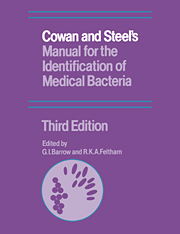Book contents
- Frontmatter
- Contents
- Foreword
- Preface to the first edition
- Postscript
- Preface to the second edition
- Preface to the third edition
- List of contributors
- Introduction
- 1 Classification and nomenclature
- 2 Culture media: constituents and sterilization
- 3 Principles of isolation
- 4 Bacterial characters and characterization
- 5 Theory and practice of bacterial identification
- 6 Characters of Gram-positive bacteria
- 7 Characters of Gram-negative bacteria
- 8 Taxonomy in theory and practice
- 9 Bacterial identification by cards
- 10 Bacterial identification by computer
- 11 Quality control in microbiology
- Appendices
- A Preparation and control of culture media
- B Staining: reagents and methods
- C Characterization tests
- D Test organisms
- E Preparation and use of Identicards
- F Use of computers
- G The Bacteriological Code
- H The Approved Lists of Bacterial Names
- I Reconciliation of Approaches to Bacterial Systematics
- J Glossary
- References
- Index
F - Use of computers
Published online by Cambridge University Press: 15 December 2009
- Frontmatter
- Contents
- Foreword
- Preface to the first edition
- Postscript
- Preface to the second edition
- Preface to the third edition
- List of contributors
- Introduction
- 1 Classification and nomenclature
- 2 Culture media: constituents and sterilization
- 3 Principles of isolation
- 4 Bacterial characters and characterization
- 5 Theory and practice of bacterial identification
- 6 Characters of Gram-positive bacteria
- 7 Characters of Gram-negative bacteria
- 8 Taxonomy in theory and practice
- 9 Bacterial identification by cards
- 10 Bacterial identification by computer
- 11 Quality control in microbiology
- Appendices
- A Preparation and control of culture media
- B Staining: reagents and methods
- C Characterization tests
- D Test organisms
- E Preparation and use of Identicards
- F Use of computers
- G The Bacteriological Code
- H The Approved Lists of Bacterial Names
- I Reconciliation of Approaches to Bacterial Systematics
- J Glossary
- References
- Index
Summary
The availability of laboratory-based computers is increasing considerably, not only because of reductions in their price and size but also because programs suitable for epidemiological and microbiological purposes are more readily available. Historically, laboratory computing developed from the work of relatively few laboratories with limited access to the large mainframe computer facilities available in the 1960s. These were the ‘first generation’ of laboratory computers. They have all been replaced now by second and even third generation computer ‘hardware’ (the collective term used to describe the computer processor, the magnetic disk or tape storage apparatus as well as the visual display terminals and printer) and the associated ‘software’ (the programs for various applications). With the development of the ‘silicon chip’ all the associated hardware and software is available now for small sized micro-computers which have memory power and data storage capacity equivalent to those of their large predecessors. Any detailed description will undoubtedly soon be out of date but computer facilities with visual display terminals, printers, and adequate magnetic disk storage for as much as three years' clinical laboratory workload together with the necessary software (and training) are currently available at a modest cost. Such computer systems are well suited not only for bacterial identification purposes but also for a broad range of other uses in the microbiology laboratory.
- Type
- Chapter
- Information
- Publisher: Cambridge University PressPrint publication year: 1993



